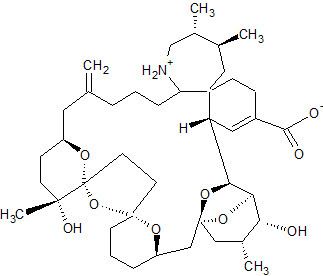 | ||
Pinnatoxins are neurotoxic chemical compounds that inhibit neuronal and muscle-type nicotine acetylcholine receptors. They are produced by the peridinoid dinoflagellate Vulcanodinium rugosum and consist of several subtypes.
Contents
Chemistry
Pinnatoxins are part of the cyclic imine group of marine toxins. This group currently consists of pinnatoxins, pteriatoxins, spirolides, gymnodimines, spiro-prorocentimine and portimine. Eight different types of pinnatoxins have been described, named pinnatoxin A to H.
All the pinnatoxins contain several key structural elements. The structure of pinnatoxin is composed of a cyclic imine (A ring) spirolinked to a cyclohexene ring (G ring), a dispiro 6,5,6 tricyclic ketal at C12-C23 (rings B, C, D), a bridged bicyclic ketal at C25-C30 (rings E, F) and a 27-membered macrocyclic ring spanning C5-C31.
Table: molecular formula and molecular weight of pinnatoxins
Target
Pinnatoxin A, G, E and F display a high-affinity antagonism for the neuronal α7 and muscle α12βϒδ nicotine acetylcholine receptors (nAChRs). The affinity of pinnatoxins for nAChR subtypes is the result of a selectivity mechanism: the bulky bridged EF-ketal ring, specific for pinnatoxins, is able to interact with the sequence-variable loop F of the nAChRs.
The inhibitory potency of pinnatoxin A depends on the nAChR subtype. It has the following ranking in selectivity: α7> α12βϒδ>α4β2. Pinnatoxin A has a 300-fold greater potency toward the α7 than to the α4β2 nAChR. Furthermore, the blocking of α7 appears to be irreversible.
Pinnatoxin G shows no selectivity between the two neuronal subtypes α7 en α4β2 nAChRs. In contrast, pinnatoxin G interacts with 25-fold higher affinity than pinnatoxin A on the muscle-type nAChR. So the selectivity rank ordering of pinnatoxin G is α12βϒδ> α7 > α3β2 α4β2. Pinnatoxin E and F have the same order of selectivity for these receptors, although they differ in their potency. The rank order of potency at all receptors is F>G>E.
Mode of action
Pinnatoxins are potent inhibitors of neuronal and muscle type nicotine acetylcholine receptors (nAChRs). They block the nAChR through adherence to the receptor binding site. Different subregions of the pinnatoxin molecule have multiple anchoring points in the receptor-binding site, through which they dictate the tight binding between the opposing loops C and F at the nAChR subunit interface.
When pinnatoxin G and F are bound to the nAChR, they can both reduce or even abolish the amplitude of miniature endplate potentials and nerve-evoked endplate potentials. They do not have an effect on the firing frequency or resting membrane potential. This is characteristic of a postsynaptic mechanism of action.
Toxicity
As of today, no pinnatoxin or cyclic imine has been linked to human poisoning. The toxic effects of pinnatoxin E-H have, however, been examined on female Swiss albino mice.
Table: Approximate LD50, NOAEL and time to death for fed mice after pinnatoxin admission by intraperitoneal injection
a. Not determined
Table: Approximate LD50, NOAEL and time to death for fed mice after pinnatoxin admission by gavage
a. Not determined
Table: Approximate LD50 and NOAEL for fed mice after pinnatoxin admission by voluntary consumption using cream cheese as vehicle,b
a. Not determined
b. Effects of different vehicles on LD50 or NOAEL value were not significantly different
Lethal dose admission
The symptoms of intoxication in mice after lethal dose admission of pinnatoxin by intraperitoneal injection are very similar between pinnatoxin E, F, G and H. The symptoms start off with a period of hyperactivity until 10–20 minutes after injection, when an abrupt decrease in activity occurs. In the case of pinnatoxin H injection, mice become immobile instead of hyperactive. During this decrease in activity/occurrence of immobility, abdominal breathing and extension of the hind legs are observed. In some cases, mice suffer from slight exophthalmia. After this period, during which the respiration rate remains normal, the respiration rate declines rapidly within a 2 to 3-minute time interval. Death is preceded by a brief period of running movements, the occurrence of cyanosis and severe exophthalmos. The time between dosing and death varies between 14 and 50 minutes.
Apart from the greater time to onset of inactivity and abdominal breathing at lethal doses (25–40 minutes), and the time to death (approximately 1.3 hours), the symptoms after pinnatoxin E, F or G admission by gavage do not differ much from admission by intraperitoneal injection. In contrast, the time to death after admission of pinnatoxin H by intraperitoneal injection or gavage did not differ.
Sublethal dose admission
The behavioural abnormalities observed in mice after a sublethal dose start off with a hyperactive or immobile period shortly after toxin admission, and end with a full recovery. Furthermore, none of the toxins described above lead to aberrant behaviour or abnormal appearance during a subsequent 14-day observation period, nor do they result in any atypical observations at necropsy. However, the symptoms after the hyperactive/immobile period until full recovery, differ between the pinnatoxins:
